These Vegan Slider Buns or Ladi Pav are super easy to make and always delicious.
Besides being great for sandwiches they pair perfectly with a large number of mains like pav bhaji. No butter, no milk and egg-free; this version does not compromise on taste!
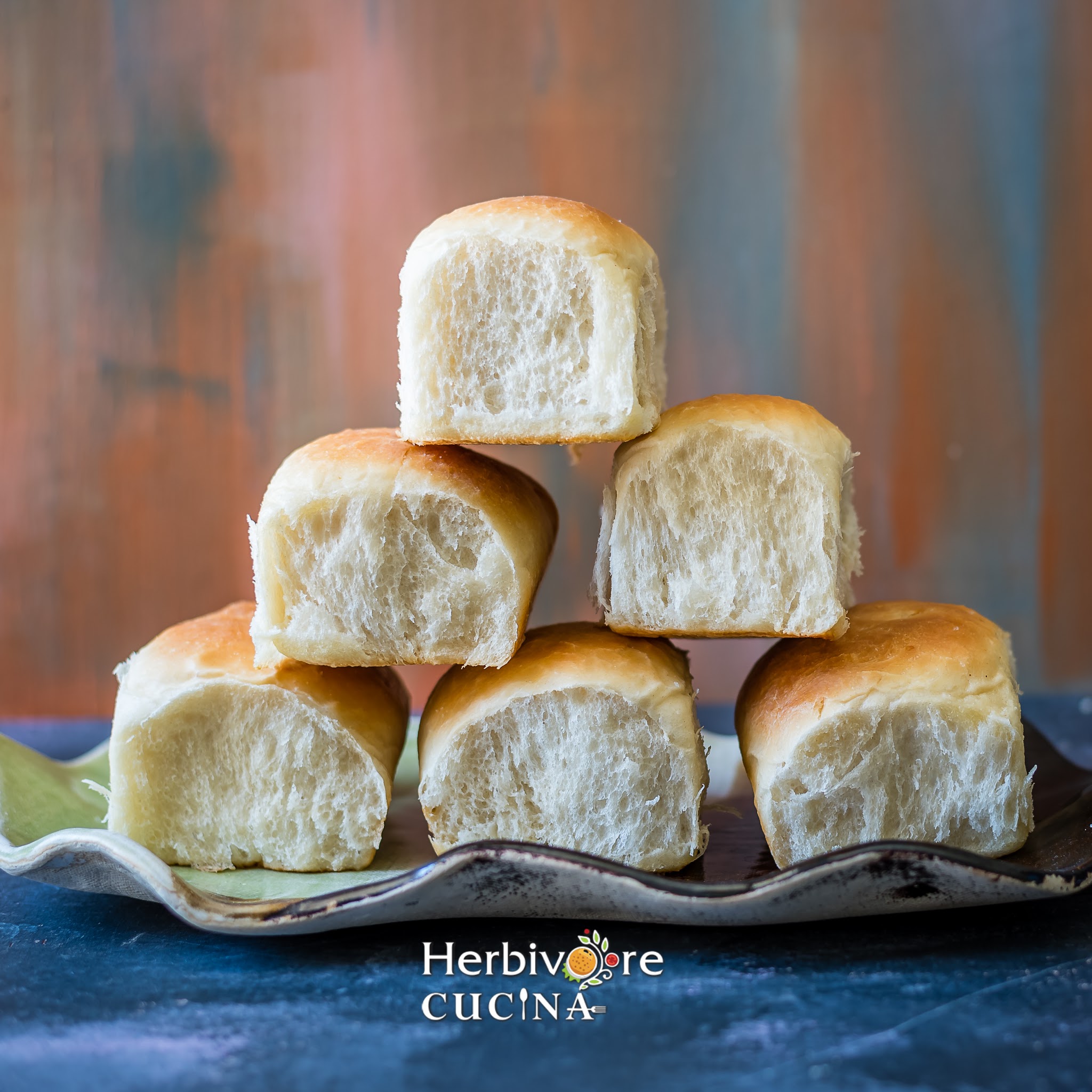
Breads are one of the best things to bake at home. The aroma of bread baking in the oven and then slicing fresh bread and enjoying it with some butter is unmatched.
From the simplest whole wheat bread loaf to sandwich loaf and the more complex ciabatta rolls and jalapeño cheddar bread; we enjoy them all at home. They come handy to make delicious sandwiches or simply en joy as is.
While some may argue that baking bread is complex, it is actually not very challenging. It is more to do with science than cooking. The steps are all scientific and the measurements are generally defined.
Blooming the yeast at a set temperature, measuring ingredients and following the steps is all it takes to make delicious bread.
Jump to:
What is Ladi Pav
The universe of breads is super vast. From different flours and add-ins to various shapes and colors, all breads have their signature. Ladi pav is popularly known as pav bhaji pav in India.
The origin of the name ladi pav is quite debatable. Some say pav or pao in Hindi means quarter and as these breads are generally sold as a set of 4 they are called pav. Some refer that the dough for pav was made by stomping on it with feet (pau in Hindi) and so the name. And the word ladi refers to tiles and the bread is served as a set of pavs that look like evenly set square or rectangle tiles.
No matter the name, pav is super popular throughout the country. It is served with so many dishes and finds application in different cuisines from the country. It is no surprise to see scores of pav bread being transported across Mumbai each day.
Vegan Slider Buns
The regular recipe of slider buns and pav uses unsalted butter as the fat. However, over the years there has been a lot demand for Vegan recipes. I have some readers who prefer Vegan recipes for various reasons.
It is pretty easy to make breads Vegan. The only dairy based ingredient is the fat in the recipe and that we use to brush on top. When we use oil for both these purposes, the recipe becomes Vegan.
Pro Tip: Yeast is naturally Vegan. There is lot of literature that supports this. And so we do not need a substitute for it in the recipe.
Why this recipe works
- It is made Vegan.
- The breads are perfect to use in so many recipes including pav bhaji, vada pav and dabeli.
- We make this recipe free from eggs.
- These are also perfect to make any kind of sliders.
- The breads we make here are not very sweet.
- We can make these ahead of time.
- It is easy to scale these up or down by simply adjusting the ingredients.
- The recipe is super versatile and the dough can work to make different shapes of bread too.
- The bread is so much better than store bought pav.
Ingredients and Substitutions
- All purpose flour: The prime ingredient in the recipe is all purpose flour. The recipe can easily be made with whole wheat flour too. Simply add some essential gluten to the wheat flour.
- Yeast: Both Instant and Active dry yeast works just fine. The activation of the yeast differs. I have used active dry yeast activated with warm water, salt and sugar in the recipe.
- Olive Oil: As the rolls are Vegan, I add Olive oil as the fat. Plus we need some to grease the pan and the rolls. We can also use any plant based butter for the same. Simply bring it to room temperature and use it. For a non-vegan version, unsalted butter works too.
- Salt and Sugar: We need some salt and sugar to activate the yeast. Plus, I like to add some salt to the bread dough. If you like your breads sweet, add some sugar to the dough too.
- Coconut Milk: I like to use coconut milk to brush the buns. That way they get the perfect crust and yet keep the buns Vegan.
- Other add-ins: These plain buns are easy to make with herbs and add-ins. Add some parsley, oregano, cilantro, thyme or mint leaves to make these flavored. Moreover, adding seeds like sesame, pumpkin, carom seeds etc makes them delicious too.
See the recipe card for detailed ingredient information, measurements and nutrition.
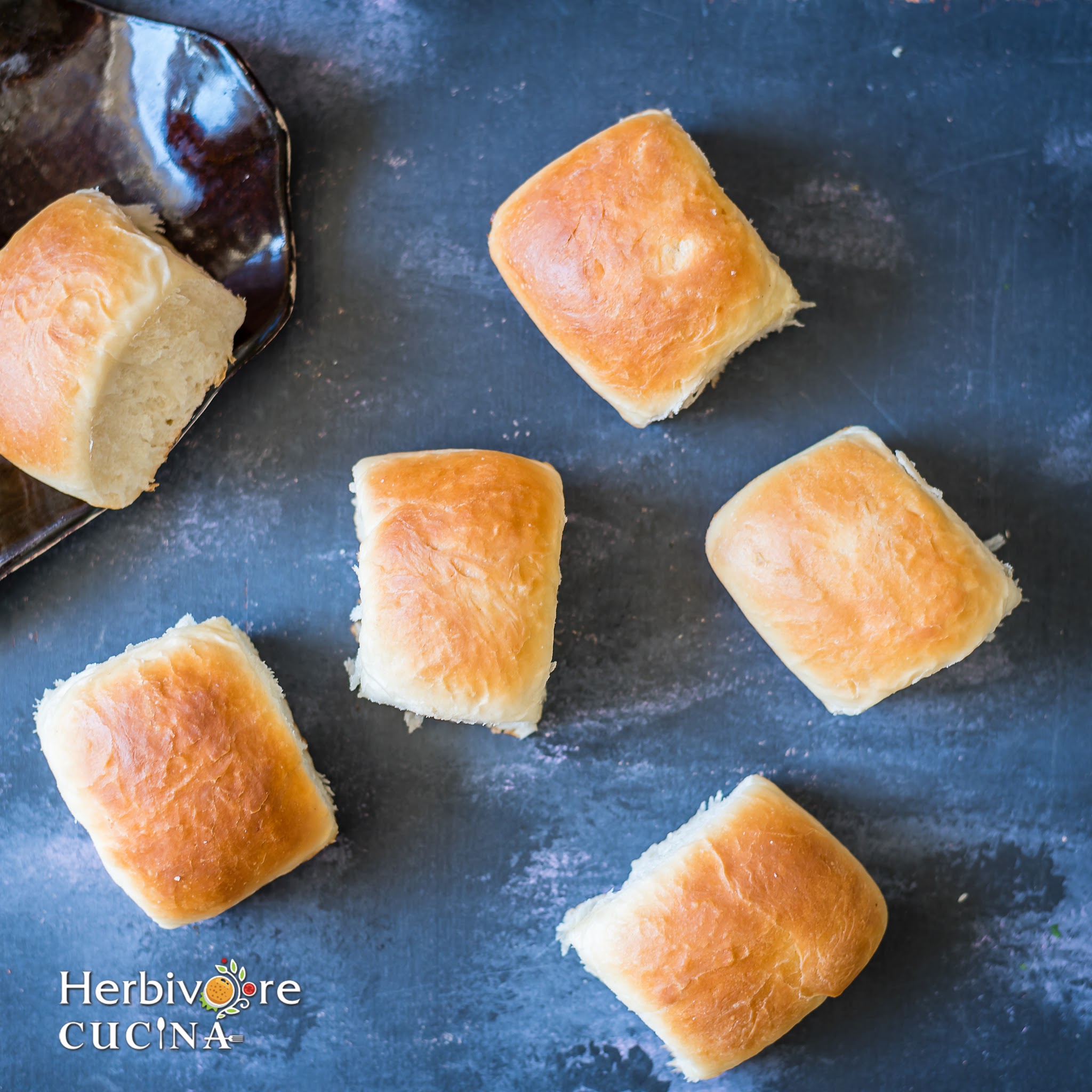
How to make this recipe
1- Heat 1 ¼ cup water till just warm (105-110 F). Add in 1 teaspoon salt, sugar and yeast.
2- Set aside till the yeast blooms.
3- In the base of a stand mixer or a big bowl add flour, remaining salt, olive oil and bloomed yeast mix.
4- Mix on medium speed till it all comes together. The dough should be soft to touch.
5- Coat the dough ball with some oil or vegan butter and rest for an hour in a warm place till it doubles.
6- When the dough doubles, open the cover.
7- Lightly punch the dough down.
8- Divide into 8-10 equal size parts. Using a kitchen scale is generally the best way to get them all of the same size.
9- Roll each ball into a smooth ball. Ensure the dough ball is tight so it does not develop a cavity on baking.
10- Line a baking tray with some oil and place the dough balls on it. Make sure these are placed one inch apart. Placing them further apart will not make them touch each other on rising and baking.
11- Brush some oil on top and let the rolls rise for an hour. Meanwhile preheat oven to 400 F (200 C).
12- Once the breads double in size, brush coconut milk (or oil) on all of them.
13- Place the tray in the oven and bake for 15-18 minutes, till the top is golden brown.
14- Remove and enjoy with either butter and jam or in any of your favorite recipes like pav bhaji, vada pav and dabeli.
Expert Tips and Notes
- Working with yeast: Working with yeast is actually easier than most believe it to be. Make sure the yeast is new and not very dated. Also, I like to buy them in sachets as they are pre-measured and not susceptible to moisture. The bottled ones often clump together and cannot be used after.
- Blooming the yeast: Use warm water (between 105-110F) to bloom the yeast. Cool water will not activate the yeast and super hot water tends to burn the yeast down. Also ensure you add some salt and sugar to activate and later feed the yeast respectively.
- Substituting the flour: I generally make this using all purpose flour as it is perfect in texture and taste. However, we can make these with whole wheat flour or bread flour too. The texture will vary but the bread is still amazing.
- Placing the pav: The signature pav bread that has soft edges is easy to achieve by correctly placing the dough balls. These need to be close enough to stick to each other on rising but not so close that they all fuse into one bread. So place them about an inch away from each other.
- Making non-Vegan buns: The only ingredient that we would change to make these vegetarian but not Vegan is Oil. Simply swap that with unsalted dairy based butter to make the ladi pav.
- Cooling the pav: Once the buns are baked, remove the pan from the oven and let it cool for 5-10 minutes. After that transfer to a wire rack so the breads do not get soggy on the bottom.
Using the Instant Pot
Using the Instant Pot to proof the dough is optional but I like to use it. Given that we generally make these around Fall, the temperatures are not particularly warm in most regions.
Thus, the dough may not rise well on the kitchen counter. Instead we use the instant pot to make sure the dough rises irrespective of temperatures outside. This timed method helps estimate the correct time for making the bread and works year round.
However, if you like or are in a warmer place, simply place the dough on the counter and rest covered for an hour to 1.5 hours to rise. Then follow th remaining steps.
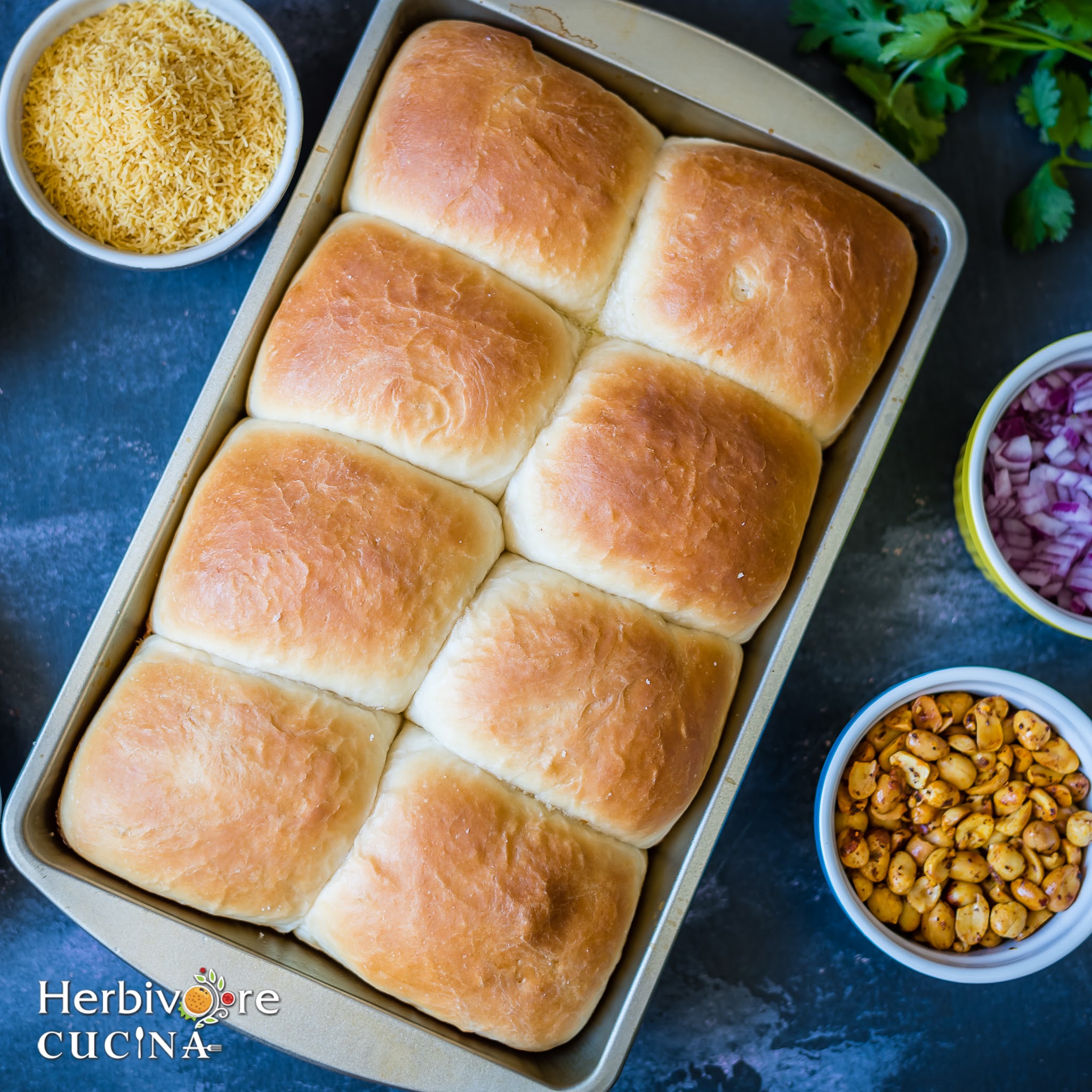
Flavoring the Buns
Plain slider buns are perfect to enjoy with pav bhaji, vada pav and dabeli. However, we can flavor these with dried leaves like parsley, mint, oregano or rosemary. Moreover, add seeds like sesame, carom, pumpkin or cumin if you like. Pick and cheese the combination as you like.
These savory buns are perfect to enjoy in many ways. However, we can make sweet buns too. We can add some pineapple juice, tutti frutti, dried fruits or just additional sugar to make these sweet.
Recipe FAQs
Slider buns are perfect to make sandwiches or sliders. In India these are perfect to enjoy with pav bhaji, dabeli or vada pav. These buns are savory in taste. Similarly, dinner rolls are yeasty breads enjoyed in various parts of US. These are slightly more sweet and tend to be softer as we add some milk while making them.
Certainly. If you do not need the breads to be Vegan, use any salted butter. To keep them Vegan, pick a plant based unsalted butter.
Bread dough when made with perfectly bloomed yeast with the other ingredients tend to bake better than the ones with improper yeast. Again, placing these in a cool oven tends to disrupt the baking. In both these situations, the buns smell yeasty.
Breads tend to be dense if we do not knead the dough very well. So make sure you knead the dough well. Moreover, skimping on the fat also gives us dense buns. So try and maintain the ingredient proportions correctly.
Coconut milk is a perfect Vegan ingredient to top the buns before baking. This step makes the bread golden brown. However, it is easy to replace with a canola oil spray or even Olive oil.
It is best to bake the ladi pav on the middle rack. That way we get the crust to brown evenly while the inside bakes well too.
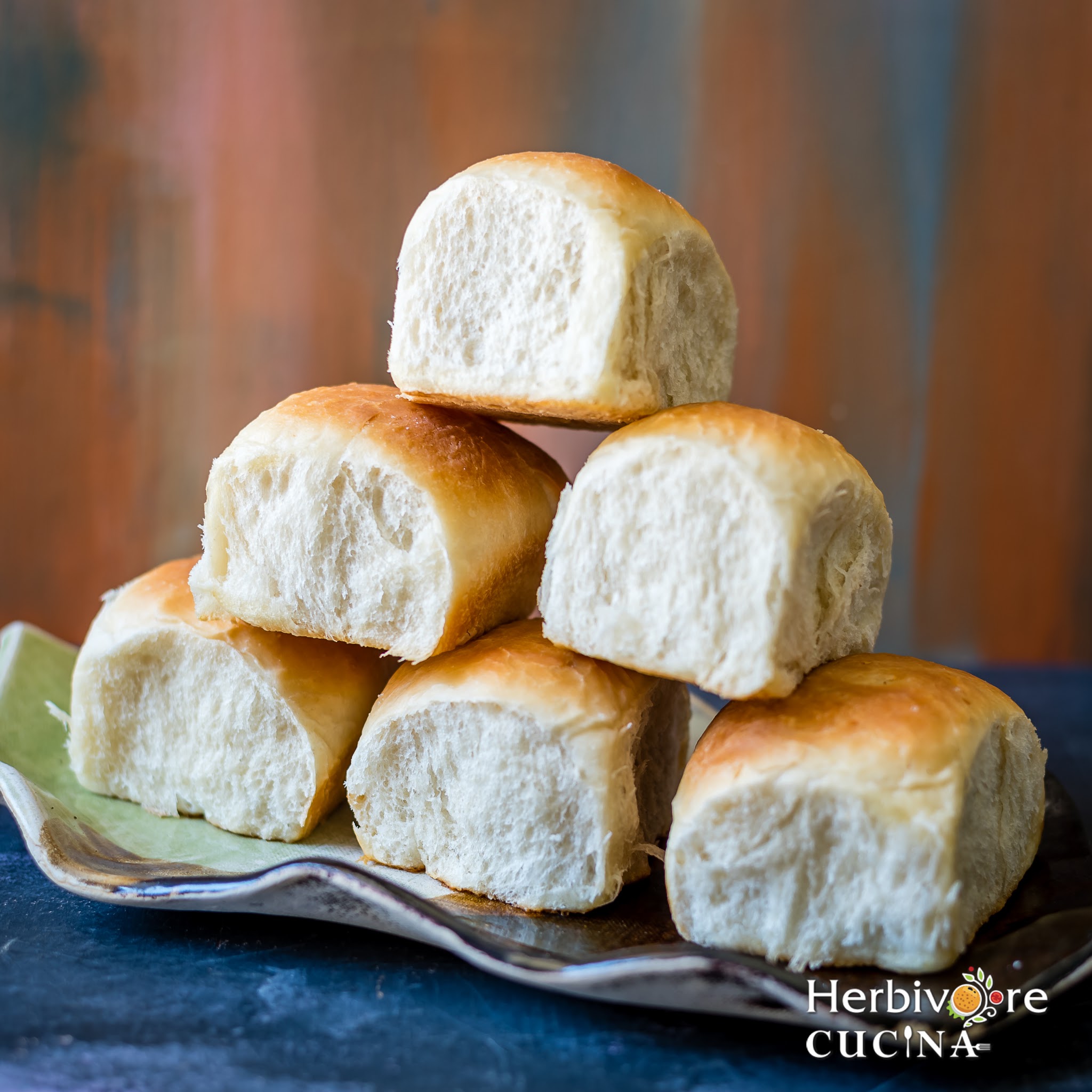
More Bread Recipes to try
Love this recipe? Please leave a star rating in the recipe card below & if you REALLY like it, consider a review in the comments whilst you are there, thanks!
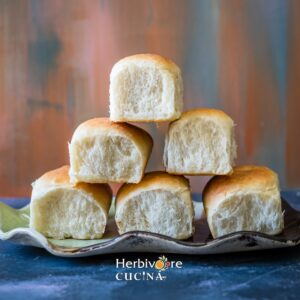
Vegan Slider Buns | Ladi Pav
Ingredients
- 3 cups All purpose flour
- 2¼ teaspoon Active Dry Yeast
- 4 tablespoon Olive Oil
- 2 teaspoon Salt
- 1 teaspoon Sugar
- 2 tablespoon Coconut Milk
- 1¼ cup Warm Water
Instructions
- Heat water till just warm (105-110 F). Add in 1 teaspoon salt, sugar and yeast.2 teaspoon Salt, 1 teaspoon Sugar, 1¼ cup Warm Water, 2¼ teaspoon Active Dry Yeast
- Set aside till the yeast blooms.
- In the base of a stand mixer or a big bowl add flour, remaining salt, olive oil and bloomed yeast mix.3 cups All purpose flour, 4 tablespoon Olive Oil
- Mix on medium speed till it all comes together. The dough should be soft to touch.
- Coat the dough ball with some oil or vegan butter and rest for an hour in a warm place till it doubles.
- When the dough doubles, open the cover.
- Lightly punch the dough down.
- Divide into 8-10 equal size parts. Using a kitchen scale is generally the best way to get them all of the same size.
- Roll each ball into a smooth ball. Ensure the dough ball is tight so it does not develop a cavity on baking.
- Line a baking tray with some oil and place the dough balls on it. Make sure these are placed one inch apart. Placing them further apart will not make them touch each other on rising and baking.
- Brush some oil on top and let the rolls rise for an hour. Meanwhile preheat oven to 400 F (200 C).
- Once the breads double in size, brush coconut milk (or oil) on all of them.2 tablespoon Coconut Milk
- Place the tray in the oven and bake for 15-18 minutes, till the top is golden brown.
- Remove and enjoy with either butter and jam or in any of your favorite recipes like pav bhaji, vada pav and dabeli.
Notes
- Working with yeast: Working with yeast is actually easier than most believe it to be. Make sure the yeast is new and not very dated. Also, I like to buy them in sachets as they are pre-measured and not susceptible to moisture. The bottled ones often clump together and cannot be used after.
- Blooming the yeast: Use warm water (between 105-110F) to bloom the yeast. Cool water will not activate the yeast and super hot water tends to burn the yeast down. Also ensure you add some salt and sugar to activate and later feed the yeast respectively.
- Substituting the flour: I generally make this using all purpose flour as it is perfect in texture and taste. However, we can make these with whole wheat flour or bread flour too. The texture will vary but the bread is still amazing.
- Placing the pav: The signature pav bread that has soft edges is easy to achieve by correctly placing the dough balls. These need to be close enough to stick to each other on rising but not so close that they all fuse into one bread. So place them about an inch away from each other.
- Making non-Vegan buns: The only ingredient that we would change to make these vegetarian but not Vegan is Oil. Simply swap that with unsalted dairy based butter to make the ladi pav.
- Cooling the pav: Once the buns are baked, remove the pan from the oven and let it cool for 5-10 minutes. After that transfer to a wire rack so the breads do not get soggy on the bottom.

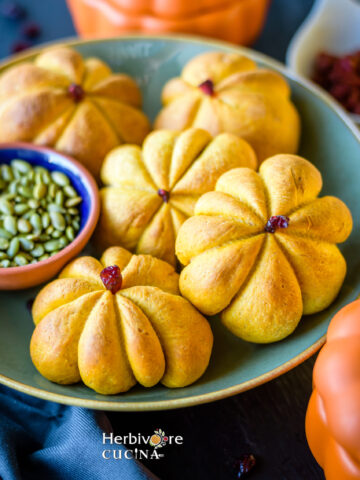
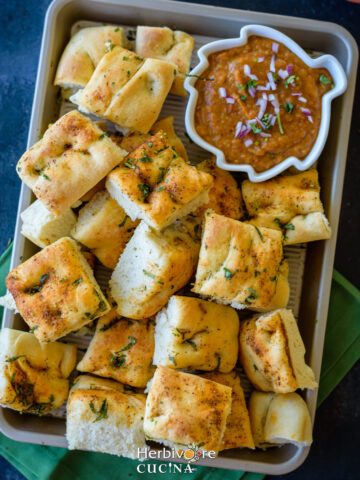
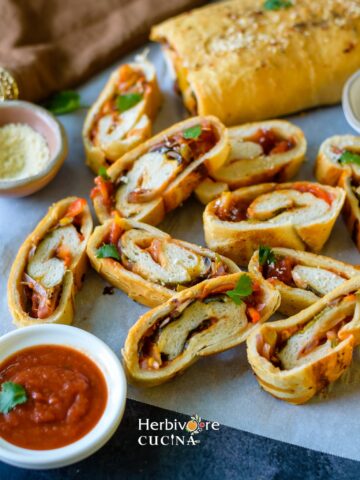
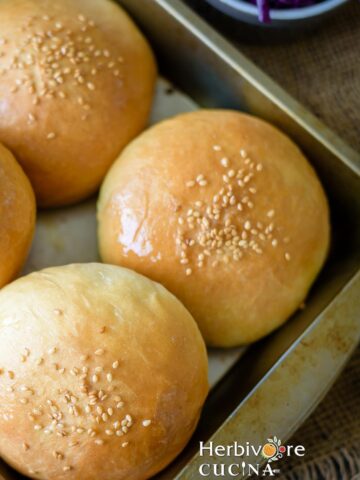
PlantBased says
Could we use almond milk instead of coconut milk?
Smruti Ashar says
Yes you can use any milk of your choice! Works well.
Nidhi Doshi says
Can I use instant yeast instead of active dry yeast? If so, what quantity and do I have to wait for it to bloom? Thanks!
Smruti Ashar says
Yes instant yeast can be used. Same quantity as active dry. Just skip the blooming step, add it directly to the flour mix.